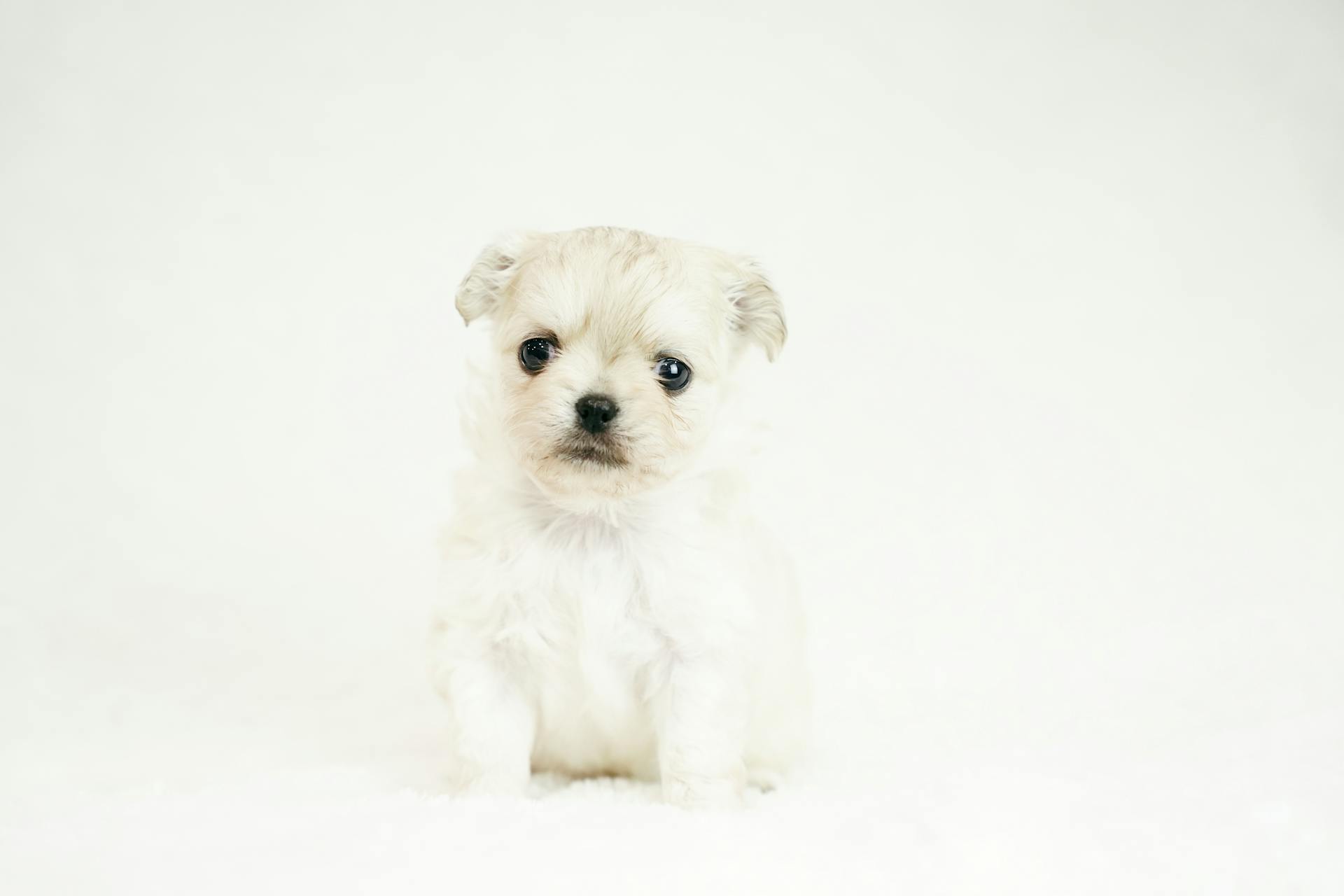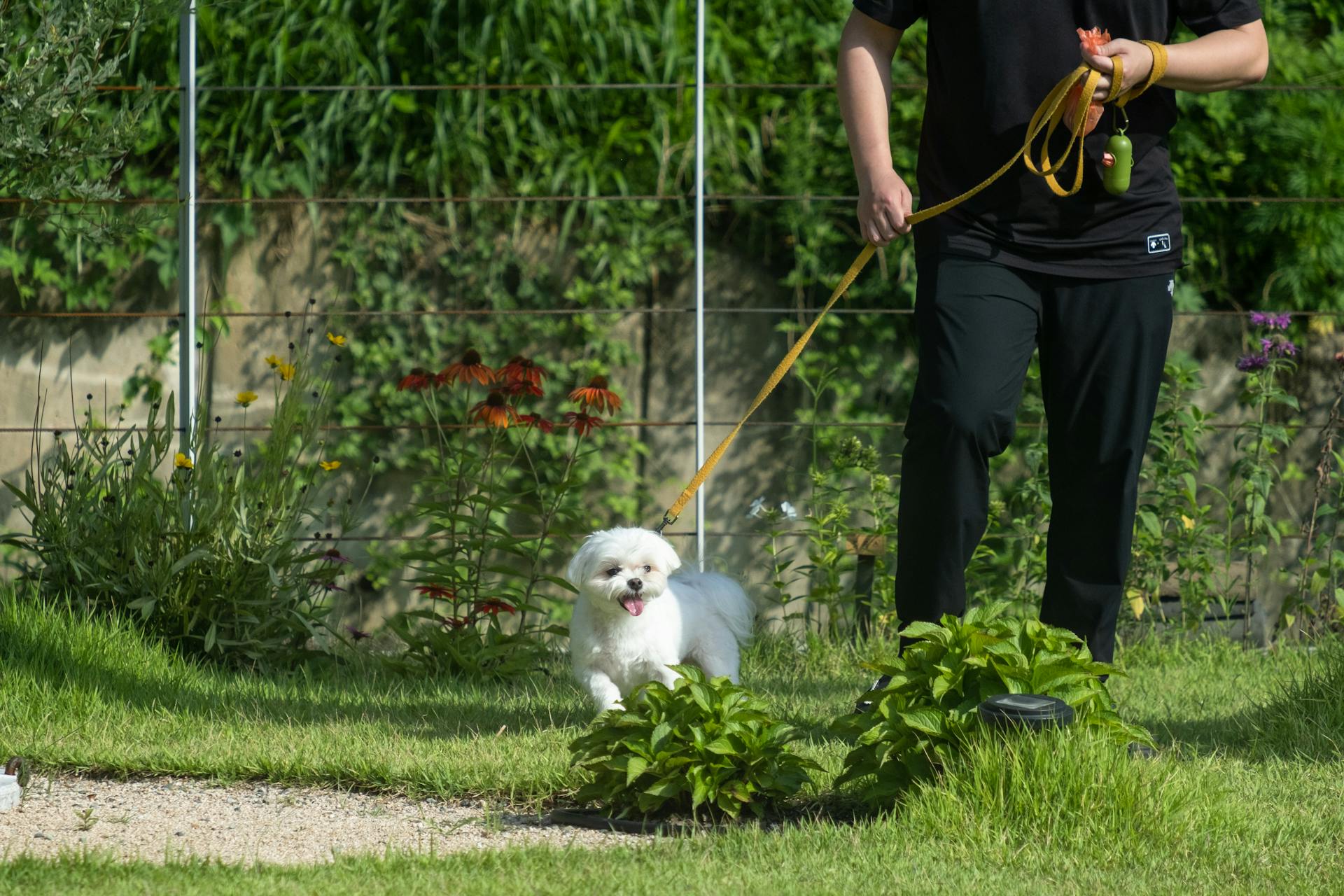
The Maltese Terrier is a small, playful dog breed that's perfect for city living. They typically weigh between 4-8 pounds and stand about 8-10 inches tall.
Their silky, white coats require regular grooming to prevent matting and tangling. This breed is known for its gentle and affectionate nature, making them a great companion for families and singles alike.
To keep your Maltese Terrier happy and healthy, make sure to provide plenty of exercise and mental stimulation. This can be as simple as a daily walk or playtime in a securely fenced yard.
Physical Characteristics
The Maltese is a small dog breed, typically growing to 7-12 inches in height and weighing between 4-8 pounds.
Their long and silky white coat is one of their most distinctive features, hanging down to the ground and requiring regular brushing to prevent matting.
Maltese dogs do not have an undercoat and shed very little, making them a great choice for people with allergies.
Their ears are cute and floppy, while their compact body and sloping shoulders give them a nicely proportioned look.
Adult Maltese dogs usually weigh between 3-4 kg (7-9 lb), with females standing about 20-23 cm (8-9 in) tall and males being slightly taller.
Their tufted tail curls over their back, adding to their adorable appearance.
The Maltese coat is dense and glossy, falling heavily along the body without curls or an undercoat, and their pure white color can sometimes have a pale ivory tinge or light brown spotting.
Personality
The Maltese terrier is a loving and affectionate breed that thrives on human interaction. They adore being close to their owners and love to cuddle.
Maltese dogs are known to be gentle and obedient, making them a great breed for families with older children. They are also intelligent and trusting, which helps with training.
One thing to keep in mind is that Maltese dogs can be prone to separation anxiety, so crate training is a good idea to help them feel safe when left alone. This will give them a cozy place to rest and reduce anxiety.
Maltese dogs are natural people pleasers and can be trained fairly easily, but they may require a little extra time and patience to housetrain. They also tend to be picky eaters, so a simple can of dog food may not be enough.
As a watchdog, Maltese dogs are alert and will react to unfamiliar noises or people with a flurry of barking. However, they are not effective protection dogs, so they shouldn't be relied upon for security.
Overall, the Maltese terrier is a wonderful breed that makes a great companion for people of all ages. They are playful, lively, and fun to be around, and with proper training and care, they can thrive in a variety of living situations.
Care and Maintenance
The Maltese terrier is a low-shedding breed, but it still requires regular grooming to prevent matting and tangling.
Their long white coat needs to be clipped every six weeks to a shorter length, or it will require daily combing to prevent knots and tangles.
Maltese dogs are prone to tear staining, so it's essential to clean the hair around their eyes every day with a soft washcloth or cotton ball.
They also need to be groomed every few months and get an occasional bath, maybe once every two to three weeks unless they get into something messy.
The Maltese's human-like hair tangles easily if not brushed and combed frequently, and it can develop broken and split ends.
To make grooming easier, many people choose to keep their Maltese in a "puppy clip", where the hair is clipped short, but it still requires regular brushing and combing.
Their silky hair can get matted in their ears, which needs to be trimmed by a groomer to prevent discomfort and infection.
Related reading: Australian Silky Terrier Short Hair
Health
The Maltese terrier is a beloved breed known for its gentle and affectionate nature, but like all dogs, they can be prone to certain health issues.
On average, a Maltese dog can live up to 12 to 14 years old. A 2024 UK study found a life expectancy of 13.1 years for the breed, which is impressive considering the average life expectancy of purebreds is 12.7 years.
Maltese dogs are generally healthy, but they can be susceptible to reverse sneezing, which sounds like a snort or honk and can be caused by overstimulation or allergies. A warm, loving cuddle can help relax your pup after an episode.
A collapsed trachea is a more serious condition that requires medical intervention, and it's characterized by a persistent dry and harsh-sounding cough. If you notice this symptom, it's essential to seek veterinary care immediately.
Some common health issues that Maltese parents submit claims for through their pet insurance plan include allergies, ear infections, gastrointestinal issues, irritated skin, and elevated liver enzymes. Here's a breakdown of the average costs associated with these conditions:
Maltese dogs are also prone to white dog shaker syndrome, which can cause shaking, tremors, and loss of coordination when they're overexcited. Although it's not painful for the dog, it can be disconcerting for the owner.
In addition to these health issues, Maltese dogs are known to be jumpers, especially when they're excited. Be sure to keep a gentle but firm grip on them while holding them in your arms, and move fragile items out of the way to prevent breakage.
Origin and History
The Maltese terrier has a rich and fascinating history that dates back thousands of years. Originating in Malta, a small island nation south of Sicily, Italy, this breed has been a favorite among royalty and nobility for centuries.
The Maltese was highly valued in ancient times, with one dog selling for the equivalent of $2,000 in the 1500s. This luxury status was fitting, given Malta's reputation for sophistication.
One of the most interesting facts about the Maltese is that they were bred as companions and "comforters" from the very beginning. In fact, they were often carried in sleeves or held in laps by ladies in carriages.
The Maltese has been a popular show dog and companion in Britain and the United States since the 19th century. They were among the first breeds to be exhibited at dog shows in the UK.
Here are some key dates in the Maltese's history:
- 1000 BCE: The Phoenicians colonize Malta, bringing small white dogs with them.
- 1500s: A Maltese dog sells for the equivalent of $2,000.
- 19th century: The Maltese becomes a popular pet in Britain and the US.
Today, the Maltese remains a beloved companion dog, cherished for their small size, loving personalities, and hypoallergenic coat.
Frequently Asked Questions
What is the difference between a Maltese and a Maltese terrier?
There is no such breed as a "Maltese Terrier", as Maltese are a distinct companion breed with their own unique characteristics. They share some similarities with terriers, but have a distinct appearance and temperament.
Are Maltese Terriers yappy?
Maltese Terriers can be prone to yapping if left alone for too long, but they're generally quiet companions for owners who provide regular attention. With proper care, they can be gentle and loving pets.
Do Maltese terriers shed a lot?
Maltese terriers are known to be low shedders, but they still require regular grooming to prevent matting and tangling of their coat. While they don't shed as much as some other breeds, they still produce some loose hair.
Is a Maltese Terrier a good family dog?
A Maltese Terrier may not be the best fit for families with small children due to their fragile nature and impatience. However, they can make great pets for first-time owners in small spaces.
What are Maltese dogs known for?
Maltese dogs are known for their gentle, affectionate, and intelligent nature, making them a great fit for families. They're lively, playful, and love to learn, but may require extra patience with rambunctious children.
Featured Images: pexels.com


